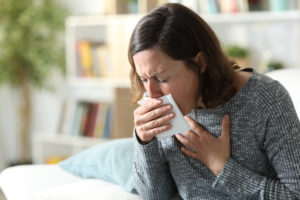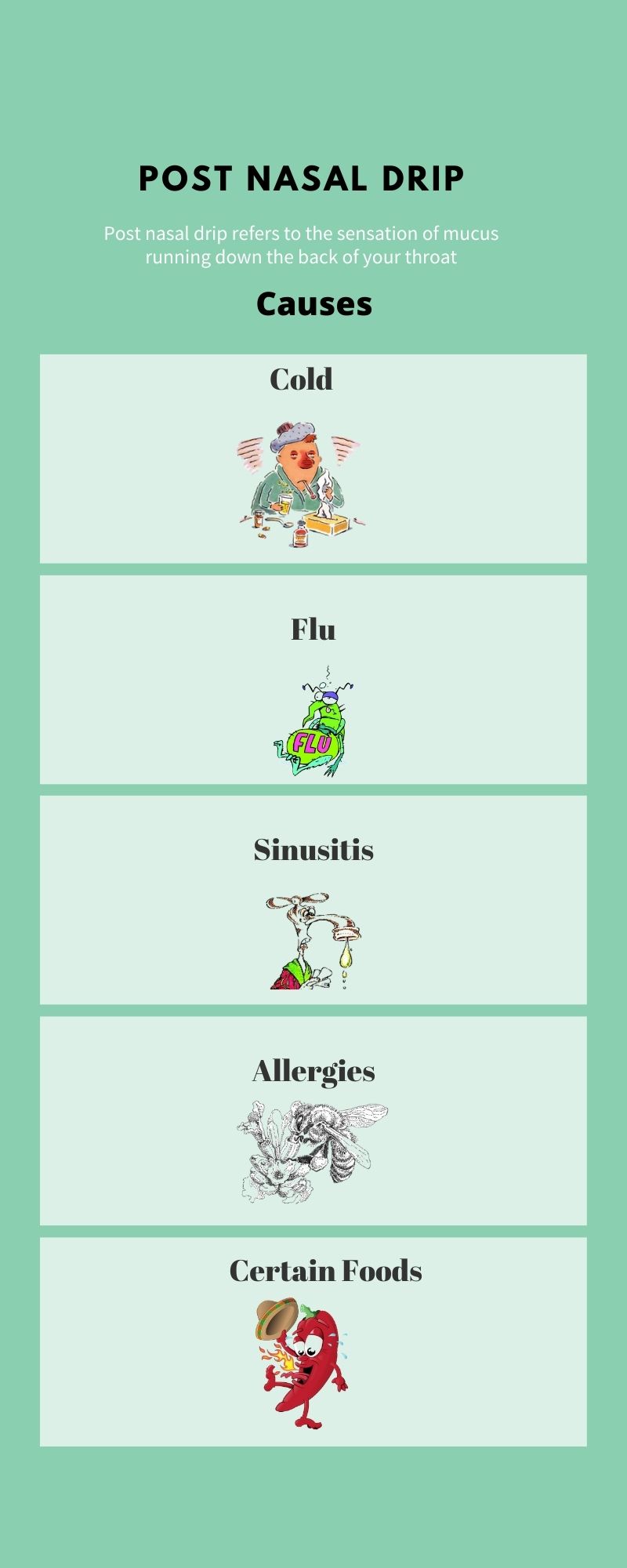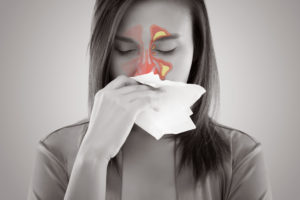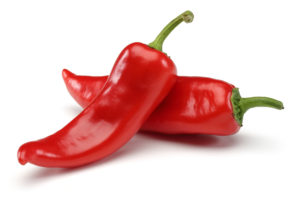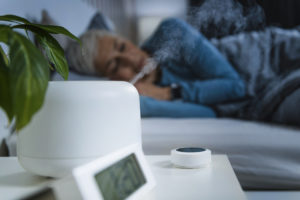Post Nasal Drip: Symptoms, Causes, and Solutions
Post nasal drip is the sensation of mucus running down the back of your throat. This often causes frequent throat clearing, cough, and other symptoms.
Post nasal drip is associated with the common cold, sinuses, seasonal allergies, and other conditions. But did you know that the glands in your nose and throat constantly produce mucus that you often swallow without realizing it?
It’s true.
Benefits of Mucus
Your body produces an estimated 4 cups of mucus per day throughout the body.1 Fortunately, your nose and throat don’t produce all of it. Rather, mucus glands line the tissues of multiple organs. This slippery mucus lubricates these sites, keeping tissues and organs from drying out. It also traps viruses, dust, and other harmful substances, keeping them from damaging the body.
Research also suggests that mucus has antibacterial properties due to its polymer content. These polymers, known as mucins, appear to trap bacteria. This keeps them from adhering to tissues and clumping together, effectively neutralizing them.
Also, mucins trap bacteria but do not kill them. This means that unlike antibiotics, bacteria are less likely to evolve resistance to mucins.2
Thus, mucus production has multiple health benefits.
It’s normal to swallow small amounts of mucus without awareness, as it easily mixes with your saliva. You’ll probably only notice mucus when it thickens or your body produces a greater amount than normal.
Symptoms of Post Nasal Drip
The most common symptom of post nasal drip is the feeling of mucus running down your throat. Other symptoms include:
- Sore, scratchy throat
- Coughing, especially at night while you’re trying to sleep
- The need to clear your throat often
- Frequent swallowing
- Hoarseness
- Foul breath
- Nausea or stomach upset due to swallowed mucus
- Feeling a blockage or lump in your throat
What Causes Post Nasal Drip?
Here are a few of the most common causes of post nasal drip.
Seasonal Allergies
Seasonal allergies, also called hay fever and seasonal allergic rhinitis, are a big trigger for post nasal trip.
More than 50 million Americans are living with either seasonal allergies, 3 which usually strike in the the spring and the fall, or allergic rhinitis, that can be seasonal or occur year round. (Allergic rhinitis can be triggered by exposure to allergens other than pollen, such as pet dander, mold, and dust.)
As plants release their pollen and you breathe it in, your immune system mistakes it for a harmful invader. In response, it releases histamines and other chemicals that cause the inside of your nose to swell. It also triggers excess mucus production to clear the harmful invaders from your nasal passages and respiratory system. In addition to post nasal drip, seasonal allergies can cause coughing, sneezing, runny nose, congested nose and chest — all to protect your body from this foreign substance.
Colds/Respiratory Flu/Sinus Infections (Sinusitis)
We all know about the common cold, respiratory flu, and sinusitis.
According to the Centers for Disease Control (CDC), adults have 2 to 4 colds per year, mostly in the winter and spring. (Children typically have more than that, though.) The miserable cold symptoms last a LONG 7-10 days.4
Influenza (flu) is a virus that infects the upper respiratory tract, causing post nasal drip, congestion, coughing, fever, and other unpleasant symptoms. The number of cases vary widely depending upon the severity of the flu season. In the 2019-2020 flu season, for instance, the CDC estimates there were an estimated $38,000 symptomatic cases of the flu.5
Sinus infection (sinusitis) is inflammation of the tissue lining the sinuses. Sinusitis can be caused by the common cold, nasal polyps, immune system deficiencies, nasal allergies, and more. Along with post nasal drip, sinusitis can lead to stuffy nose, cough, congestions, and face pain/pressure. And it’s very common. According to WebMD, an estimated 35 million Americans have sinusitis at least once annually.6
Like seasonal and nasal allergies, cold and respiratory flu viruses trigger an immune response designed to clear the virus from your body. Excess mucus production is one of the tools it uses to do this.
Cold Weather or Dry Air
If you notice mucus running from your nose and down your throat in cold temperatures or dry air, there’s a reason for that. Your body strives to protect your health, and breathing cold or dry air may irritate your nose or throat. In response, your body triggers extra mucus production to moisturize and warm those passages, soothing the irritation.
But you may also be suffering from cold or flu, viruses that typically thrive in cold weather.
Other Causes of Post Nasal Drip
Other causes of post nasal drip include:
- Deviated Septum. This condition occurs when the wall between the nostrils is crooked or damaged and can prevent mucus from draining properly. This may result in post nasal drip.
- Eating spicy foods. Chemicals in many spicy foods irritate the mucus membranes in the mouth, nose, throat and sinuses. This causes increased mucus production.
- Medications. Certain medications are known to promote excessive mucus production. Mucus-producing medications include birth control pills and some blood pressure medications.
- Pregnancy. The increased estrogen production of pregnancy triggers an increase in mucus production.
- Acid reflux. This condition occurs when stomach acid backs up into the esophagus. If it irritates the throat or lungs, it can cause extra mucus production.
- Inflammatory diseases. Chronic bronchitis, COPD, cystic fibrosis, and other inflammatory diseases are known to promote excessive mucus production. This is because the lower airways produce extra mucus in response to this inflammation.7
- Neurological inflammation. The brain is the control center of the body. Consequently, when there’s a potential problem with the respiratory system, including the nose and throat, the brain tells the body to produce more mucus to prevent any damage. If this important organ is inflamed, however, the brain can trigger excess mucus production even when there’s no real reason to do so.
Does Post Nasal Drip Go Away By Itself?
In most cases, post nasal drip will go away on its own, typically when the cause of excess mucus production goes away, i.e., when your cold leaves you, so does post nasal drip.
But if it doesn’t clear up within 10 days, you should see your doctor. This is because long-lasting untreated post nasal drip can lead to sinus infections and other conditions.
Treatments
Here are a few of the most common treatments for post nasal drip.
Decongestant Medications
Decongestants are typically used for conditions associated with nasal congestion, such as colds and allergies. They shrink swollen blood vessels and tissues, opening airways. When air can pass freely through your airways, mucus dries up and congestion is relieved. This, in turn, can reduce post nasal drip symptoms.
There are some downsides to using decongestants, however. People have reported insomnia and irritability while using these medications. Decongestant usage may also increase the risk of high blood pressure and cardiovascular events. This is particularly true with pseudoephedrine medications.8
Common OTC decongestant medications include pseudoephedrine (Sudafed) and Phenylephrine (Sudafed PE).
Antihistamines
Antihistamine medications are typically used to treat nasal allergies and seasonal rhinitis. They block histamine receptors in the body thereby down regulating the immune response to an allergen. This decreases your body’s reaction to allergens and can reduce associated symptoms, such as post nasal drip.
Common OTC antihistamines include Zyrtec, Benadryl, Allegra, and Claritin.9
Side effects include:
- Drowsiness
- Dry mouth
- Dizziness
- Headaches
Antibiotics
Some medical conditions with symptoms of post nasal drip, such as sinusitis and pneumonia, are caused by a bacterial infection. Prescription antibiotic medications are ideal for killing bacteria and indirectly relieving post nasal drip.
Antibiotics will not work for viral infections like cold or influenza, though.
Common antibiotics include penicillins and tetracyclines.
The biggest problem with antibiotics is that they kill off beneficial bacteria along with the harmful ones. This can cause several side effect including:
- Soft Stool
- Diarrhea
- Mild stomach upset
- Vaginal yeast infections
Nasal Decongestant Sprays
Nasal sprays (intranasal decongestants) are a type of decongestant that you spray inside your nose to relieve congestion in your nasal cavity.
Nasal sprays may reduce the risk of cardiovascular issues associated with some oral decongestants.
Side effects of nasal spray usage include:
- Nasal burning/stinging
- Dryness
- Anxiety
- Rebound congestions, may occur with frequent usage
Nasal Steroid Sprays
Steroid nasal sprays have been available by prescription for decades. Due to their powerful anti-inflammatory and anti-allergic properties, they may effectively relieve nasal congestion, post nasal drip, and other symptoms.
Commonly used nasal steroid sprays include Flonase, Rhinocort, and Nasonex.
Your doctor will likely monitor your usage of a steroid nasal spray, as they may cause multiple side effects including:
- Irritation, burning, itching and/or dryness of the nostrils
- Nosebleeds
- Infection of the nostrils
- Sneezing
- Headache
- Cough
Relieve the Drip Naturally
There are also a few natural remedies for post nasal drip.
Drink Plenty of Water
Drinking water and other liquids will help thin mucus so that it’s barely noticeable. For best results, drink only water or tea. Drinking orange juice, coffee, soda, or cows milk can increase mucus production and post nasal drip.
Avoid Mucus-Producing Foods
If you have a condition that causes post nasal drip, it’s best to avoid foods that increase mucus production.
Here are some foods known to cause or thicken excess mucus:10
- Ice cream
- Cheese
- Bananas
- Eggs
- Cheese
- Bread
- Butter
- Yogurt
Eat Foods that Reduce Mucus
Believe it or not, there are actually some foods known to reduce mucus!11
These foods include:
- Tuna
- Salmon
- Pumpkin seeds
- Celery
- Ginger
- Grapefruit
- Pumpkin
- Pineapple
Use a Humidifier
A humidifier is a device that adds moisture to the air.
A warm-air humidifier may loosen thick mucus and reduce post nasal drip. Thus, using a humidifier at night while you sleep is an easy way to naturally treat nasal drip. (Make sure to place it right beside your bed so that you can freely inhale the warm water vapor or steam.)
A cold-air humidifier is useful for reducing inflammation in your chest and/or your nasal passages.
Try a Neti-Pot
A neti-pot is a container that resembles a tea pot, hence its name. It is used to flush or rinse the nasal passages and sinuses with water or a saline solution. This is called nasal irrigation. But any nasal irrigation product will help relieve congestion and post nasal drip.
To avoid nasal irritation, use a saline solution in your neti-pot rather than plain water.
Take a Daily Dose of SANE Vitaae
Stop the drip NOW! SANE Vitaee contains 4 ESSENTIAL brain nutrients for neurological inflammation. Reduce brain inflammation, reduce post nasal drip! Vitaae is the only proven option to quickly and easily get these brain-saving nutrients. It’s quick. It’s easy. And it’s effective. Click here to learn more the 4 ESSENTIAL brain nutrients in this groundbreaking clinical research formula and place your order TODAY!!!
References
3- Centers for Disease Control. Allergies and Hay Fever. CDC. Page last reviewed: Mar 1, 2021. Accessed May 3, 2021. https://www.cdc.gov/nchs/fastats/allergies.htm
4- Centers for Disease Control. Common Colds: Protect Yourself and Others. CDC. Page last reviewed: Oct 7, 2020. Accessed May 3, 2021. https://www.cdc.gov/features/rhinoviruses/index.html
5- Centers for Disease Control. Disease Burden of Influenza. Page last reviewed: Oct 5, 2020. Accessed May 3, 2021. https://www.cdc.gov/flu/about/burden/index.html
6- Shital K. What Is Sinusitis? WebMD. Jul 19, 2020. Accessed May 3, 2021. https://www.webmd.com/allergies/sinusitis-and-sinus-infection
7- Fahy JV, Dickey BF. Airway mucus function and dysfunction. N Engl J Med. 2010;363(23):2233-2247. doi:10.1056/NEJMra0910061
8- Harvard Letter. Don’t let decongestants squeeze your heart. Harvard Health Publishing. Mar 2014. Accessed May 4, 2021.
9- Harding M. Antihistamines. Patient. Jul 5, 2017. Accessed May 4, 2021. https://patient.info/allergies-blood-immune/allergies/antihistamines
10- Lung Health. 21 Foods That Trigger Mucus Production (and 21 Foods That Reduce It). Lung Health Institute. Dec. 26, 2017. Accessed May 4, 2021.
11- Lung Health. 21 Foods That Trigger Mucus Production (and 21 Foods That Reduce It). Lung Health Institute. Dec. 26, 2017. Accessed May 4, 2021. https://lunginstitute.com/blog/21-foods-trigger-mucus-production-21-foods-reduce/


